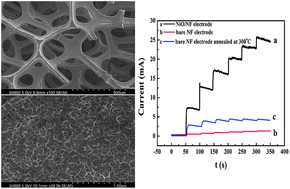
A non-enzymatic glucose sensor
Detecting glucose is not only important in the diagnosis and monitoring of diabetes; it has also wide applications in food analysis and waste water treatment. Traditional glucose sensors are based on an enzymatic method, employing glucose oxidase. Although this makes for a highly selective electrode, enzymes are easily affected by environmental factors such as temperature, humidity and pH.
Researchers led by Yongqing Zhao and Cailing Xu at Lanzhou University, China, have designed and created a new glucose sensor which is non-enzymatic and uses a 3D electrode architecture to increase the surface area in contact with the electrolyte. The porous nickel foam scaffold is loaded with nickel oxide, which has fast redox kinetics and better stability towards air and water than nickel metal.
The sensor has been evaluated against traditional methods by measuring glucose levels in blood serum samples and was found to perform well, with excellent response times, high selectivity, a low detection limit and good electrocatalytic activity.
To know more about this research, please access the link below. This paper will be free to read until April 2nd.
Non-enzymatic glucose sensor based on three dimensional nickel oxide for enhanced sensitivity
Chunyan Guo, Yinmei Wang, Yongqing Zhao and Cailing Xu
Anal. Methods, 2013, Advance Article
DOI: 10.1039/C3AY00067B










